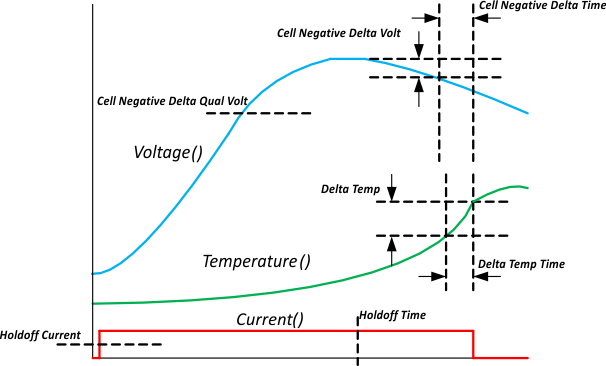SLUUCO5A december 2022 – august 2023 BQ34Z100-R2
- 1
- Read This First
- 1 Introduction
-
2 Data Commands
- 2.1
Standard Data Commands
- 2.1.1
Control(): 0x00/0x01
- 2.1.1.1 CONTROL_STATUS: 0x0000
- 2.1.1.2 DEVICE TYPE: 0x0001
- 2.1.1.3 FW_VERSION: 0x0002
- 2.1.1.4 HW_VERSION: 0x0003
- 2.1.1.5 RESET_DATA: 0x0005
- 2.1.1.6 PREV_MACWRITE: 0x0007
- 2.1.1.7 CHEM ID: 0x0008
- 2.1.1.8 BOARD_OFFSET: 0x0009
- 2.1.1.9 CC_OFFSET: 0x000A
- 2.1.1.10 CC_OFFSET_SAVE: 0x000B
- 2.1.1.11 DF_VERSION: 0x000C
- 2.1.1.12 SET_FULLSLEEP: 0x0010
- 2.1.1.13 STATIC_CHEM_DF_CHKSUM: 0x0017
- 2.1.1.14 SEALED: 0x0020
- 2.1.1.15 IT ENABLE: 0x0021
- 2.1.1.16 CAL_ENABLE: 0x002D
- 2.1.1.17 RESET: 0x0041
- 2.1.1.18 EXIT_CAL: 0x0080
- 2.1.1.19 ENTER_CAL: 0x0081
- 2.1.1.20 OFFSET_CAL: 0x0082
- 2.1.2 StateOfCharge(): 0x02
- 2.1.3 MaxError(): 0x03
- 2.1.4 RemainingCapacity(): 0x04/0x05
- 2.1.5 FullChargeCapacity(): 0x06/07
- 2.1.6 Voltage(): 0x08/0x09
- 2.1.7 AverageCurrent(): 0x0A/0x0B
- 2.1.8 Temperature(): 0x0C/0x0D
- 2.1.9 Flags(): 0x0E/0x0F
- 2.1.10 FlagsB(): 0x12/0x13
- 2.1.11 Current(): 0x10/0x11
- 2.1.1
Control(): 0x00/0x01
- 2.2
Extended Data Commands
- 2.2.1 AverageTimeToEmpty(): 0x18/0x19
- 2.2.2 AverageTimeToFull(): 0x1A/0x1B
- 2.2.3 PassedCharge(): 0x1C/0x1D
- 2.2.4 DOD0Time(): 0x1E/0x1F
- 2.2.5 VoltScale(): 0x20
- 2.2.6 CurrScale(): 0x21
- 2.2.7 EnegyScale(): 0x22
- 2.2.8 AvailableEnergy(): 0x24/0x25
- 2.2.9 AveragePower(): 0x26/0x27
- 2.2.10 SerialNumber(): 0x28/0x29
- 2.2.11 InternalTemperature(): 0x2A/0x2B
- 2.2.12 CycleCount(): 0x2C/0x2D
- 2.2.13 StateOfHealth(): 0x2E/0x2F
- 2.2.14 ChargeVoltage(): 0x30/0x31
- 2.2.15 ChargeCurrent(): 0x32/0x33
- 2.2.16 PackConfiguration(): 0x3A/0x3B
- 2.2.17 DesignCapacity(): 0x3C/0x3D
- 2.2.18 DataFlashClass(): 0x3E
- 2.2.19 DataFlashBlock(): 0x3F
- 2.2.20 AuthenticateData/BlockData(): 0x40…0x53
- 2.2.21 AuthenticateChecksum/BlockData(): 0x54
- 2.2.22 BlockData(): 0x55…0x5F
- 2.2.23 BlockDataChecksum(): 0x60
- 2.2.24 BlockDataControl(): 0x61
- 2.2.25 GridNumber(): 0x62
- 2.2.26 LearnedStatus(): 0x63
- 2.2.27 Dod@Eoc(): 0x64/0x65
- 2.2.28 QStart(): 0x66/0x67
- 2.2.29 TrueRC(): 0x68/0x69
- 2.2.30 TrueFCC(): 0x6A/0x6B
- 2.2.31 StateTime(): 0x6C/0x6D
- 2.2.32 QmaxPassedQ(): 0x6E/0x6F
- 2.2.33 DOD0(): 0x70/0x71
- 2.2.34 QmaxDod0(): 0x72/0x73
- 2.2.35 QmaxTime(): 0x74/0x75
- 2.2.36 Data Flash Interface
- 2.1
Standard Data Commands
-
3 Fuel Gauging
- 3.1 Overview
- 3.2
Impedance Track Variables
- 3.2.1 Load Mode
- 3.2.2 Load Select
- 3.2.3 Reserve Cap-mAh
- 3.2.4 Reserve Cap-mWh/cWh
- 3.2.5 Energy Scale
- 3.2.6 Dsg Current Threshold
- 3.2.7 Chg Current Threshold
- 3.2.8 Quit Current, Dsg Relax Time, Chg Relax Time, and Quit Relax Time
- 3.2.9 Qmax
- 3.2.10 Update Status
- 3.2.11 Avg I Last Run
- 3.2.12 Avg P Last Run
- 3.2.13 Cell Delta Voltage
- 3.2.14 Ra Tables
- 3.2.15 StateOfCharge() Smoothing
- 3.2.16 Charge Efficiency
- 3.2.17 Lifetime Data Logging
- 3.3 Device Configuration
- 3.4 Voltage Measurement and Calibration
- 3.5 Temperature Measurement
- 3.6 Overtemperature Indication
- 3.7 Charging and Charge Termination Indication
- 3.8 The Scale Factors
- 3.9 LED Display
- 3.10 Alert Signal
- 3.11 Fast Resistance Scaling
- 4 Communications
- 5 Device Functional Modes
- 6 Power Control
- 7 Data Flash Summary
- 8 Gas Gauge Timing Considerations
- 9 HDQ Communication Basics
- 10Procedures to Seal and Unseal the Gauge
- 11Impedance Track Gauge Configuration
- 12Revision History
3.7 Charging and Charge Termination Indication
For proper BQ34Z100-R2 operation, the battery per cell charging voltage must be specified by the user in Cell Charge Voltage Tx- Tx+1in data flash. The default value for this variable is Cell Charge Voltage T2-T3 = 4200 mV. This parameter should be set to the recommended charging voltage for the entire battery stack divided by the number of series cells.
The device detects valid charge termination in one of three ways:
- Current Taper method:
- During two consecutive periods of Current Taper Window, the is less than Taper Current AND
- During the same periods, the accumulated change in capacity >Min Taper Capacity AND
- Voltage() is > ChargeVoltage() – Cell Taper Voltage*Number of series cell /VoltScale(). When this occurs, the [CHG] bit of Flags() is cleared. Also, if the [RMFCC] bit of Pack Configuration is set, and RemainingCapacity() is set equal to FullChargeCapacity().
Current Taper method can be used to support Charge Termination Detection for applications based on Li-Ion, LiFePO4, PbA chemistries.
- Delta Temperature (ΔT/Δt)
method—For ΔT/Δt, the
BQ34Z100-R2
detects an increase in temperature over many seconds. The ΔT/Δt setting is
programmable in the temperature step, Delta Temp (0°C – 25.5°C),
and the time step, Delta Temp Time (0 s–1000 s). Typical settings
for 1°C/minute include 2°C/120 s and 3°C/180 s (default). Longer times may be
used for increased slope resolution.
In addition to the ΔT/Δt timer, a holdoff timer starts when the battery is charged at more than Holdoff Current (default is 240 mA), and the temperature is above Holdoff Temp. Until this timer expires, ΔT/Δt detection is suspended. If Current() drops below Holdoff Current or Temperature() below Holdoff Temp, the holdoff timer resets and restarts only when the current and temperature conditions are met again.
Delta Temperature(ΔT/Δt) method can be used to support Charge Termination Detection for applications based on NiMH or NiCd chemistries.
- Negative Delta Voltage (–ΔV)
method—For negative delta voltage, the
BQ34Z100-R2
detects a charge termination when the pack voltage drops during charging by
Cell Negative Delta Volt for a period of
Cell
Negative Delta
Time
during which time Voltage() must be greater than Cell Negative Qual
Volt.
Negative Delta Voltage(-ΔV) method can be used to support Charge Termination Detection for application based on NiMH or NiCd chemistries.
When either condition occurs, the Flags()[CHG] bit is cleared. Also, if the [RMFCC] bit of Pack Configuration is set, and RemainingCapacity() is set equal to FullChargeCapacity().
 Figure 3-1 NiXX
Termination
Figure 3-1 NiXX
Termination